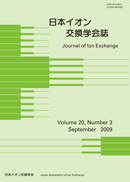All issues

Volume 20 (2009)
- Issue 3 Pages 110-
- Issue 2 Pages 64-
- Issue 1 Pages 2-
Volume 20, Issue 3
Displaying 1-3 of 3 articles from this issue
- |<
- <
- 1
- >
- >|
Award Paper
-
Tatsuya SUZUKI2009 Volume 20 Issue 3 Pages 110-115
Published: 2009
Released on J-STAGE: August 30, 2013
JOURNAL FREE ACCESSThe nuclide separation from high level radio wastes (HLRW) or spent nuclear fuels generated in nuclear facilities is developed. This separation system is based on the chromatographic technique using the pyridine resin. Since the pyridine resin has high radiation resistance, it is appropriate for use in high irradiation environments such as nuclide separation from HLRW. The pyridine group has two chemical functions; one is soft donor ligand, another is weakly basic anion-exchanger. This chemical feature is beneficial to separation of many kinds of elements including in HLRW. The group separation of trivalent minor actinides (MA) and rare earth elements (REE), mutual separation of MA and REE, Sr and Cs separation, etc. were carried out and achieved. It was found that the soft donor ligand function of pyridine group is develop in hydrochloric acid system and the anion-exchanger function is developed nitric acid system in the case of MA and REE adsorption on pyridine resin.
View full abstractDownload PDF (861K)
Award Paper
-
Goro FURUMOTO, Yosuke KOIZUMI, Noboru KUBOTA2009 Volume 20 Issue 3 Pages 116-119
Published: 2009
Released on J-STAGE: August 30, 2013
JOURNAL FREE ACCESSA novel membrane containing cation-exchange group has been developed for final polishing of ultra pure water.
Ion adsorption membrane can remove metal ions of sub-ppt level almost completely with the better duration of life.
At the same time there are little TOC and metal release from the membrane. So, at the practical use, operation can be started with less lead time.
View full abstractDownload PDF (662K)
Article
-
Takayuki SAITOH, Kanji MATSUMOTO, Kazuho NAKAMURA, Wakako HIRAYAMA, Ta ...2009 Volume 20 Issue 3 Pages 120-126
Published: 2009
Released on J-STAGE: August 30, 2013
JOURNAL FREE ACCESSIf the chain of linear polyether is grafted onto an organic polymer material, a variety of metal ions in the solvent are expected to be captured by grafted oxyethlene molecular chains owing to the free movement of the chains. PE-g-PEGME#1) with a different chain length was synthesized bonding linear polyether to 4-Chloromethylstyrene (CMS) of polyethelene (PE) non-woven fabric synthesized by graft polymerization. The interaction between the linear polyether chain and the metal ions of perchlorate, which are partially soluble in the organic solvent, were investigated by the ion adsorption test using a flow column and the coordination bond strength using NMR spectra. The following results were obtained: PE-g-PEGME coordinated to many species of metal ion. When the solvent was isopropanol (IPA), the strength of ion selectively was on the order of Na+<Mg2+<K+<Ca2+. Furthermore, PEGME strongly coordinated to Na+ ion in a solvent of small permittivity, and the order of coordination strength was water <Acetonitrile (ACN)<IPA. The longer the oxyethylene chain of PEGME was, the higher the 1H-NMR chemical shift was, and the coordination of Na+ ion was shown to be strong at the longer oxyethylene chain of PEGME.
#1) Polyethylene-graft-methylstyrene-poly (ethyleneglycol) monomethyl ether
View full abstractDownload PDF (637K)
- |<
- <
- 1
- >
- >|